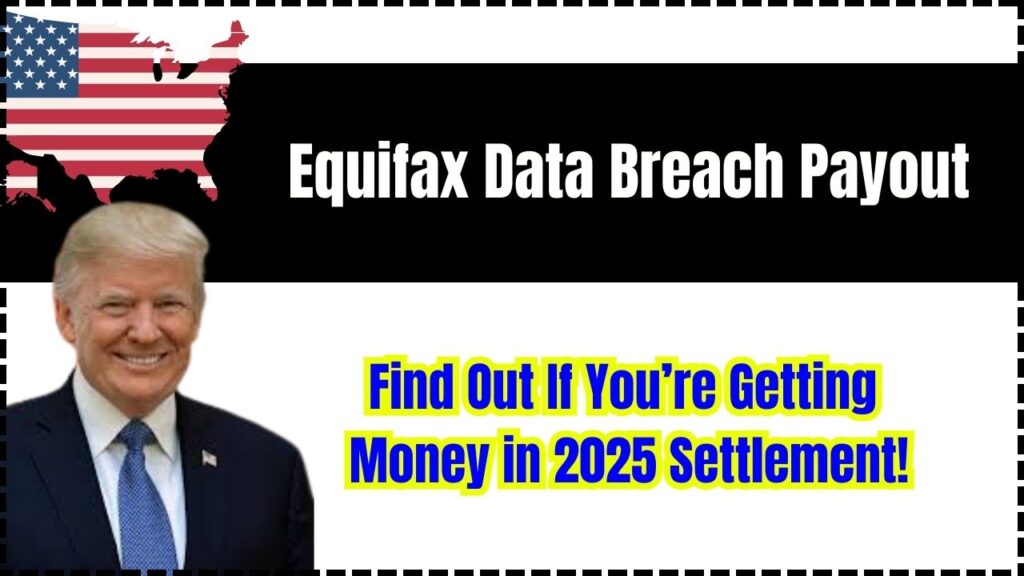Equifax Data Breach Payout: In 2017, one of the largest and most impactful data breaches in history hit Equifax, one of the three major credit reporting agencies in the United States. The Equifax data breach exposed the sensitive personal data of nearly 147 million Americans, including names, Social Security numbers, birth dates, addresses, and in some cases, driver’s license and credit card numbers. Fast forward to 2025, many affected individuals are now eligible to receive a second round of compensation following the initial settlement. If you’re wondering whether you’re one of them, this in-depth guide will help you understand exactly what’s happening and what to do next.

Whether you’re just hearing about the Equifax 2025 data breach payout or eagerly waiting for funds to land in your account, this comprehensive guide explains everything you need to know—in plain language. We’ll cover eligibility, how the payments are made, what to do if you missed the deadline, and how to protect your personal data going forward.
Equifax Data Breach Payout
| Feature | Details |
|---|---|
| Settlement Year | 2025 |
| Breach Date | 2017 |
| People Affected | ~147 million Americans |
| Claim Deadline | January 22, 2024 |
| Current Payout Type | Second round of payments (via prepaid card) |
| Payment Source | Remaining funds from $425 million restitution fund |
| Eligible Participants | Those who filed valid claims by the deadline |
| Average Payment Range | From a few dollars to under $40 |
| Official Website | www.EquifaxBreachSettlement.com |
The Equifax 2025 data breach payout is part of a multi-year restitution effort to compensate Americans whose personal information was exposed in the 2017 cyberattack. If you filed a valid claim before the 2024 deadline, be sure to check your email and redeem your payment.
And remember—even if you didn’t qualify for the money, you still have access to powerful identity protection tools through 2029. Use this opportunity to take your online security seriously and stay one step ahead of fraud.
What Happened: A Detailed Recap of the Equifax Breach
In 2017, hackers exploited a known vulnerability in Equifax’s Apache Struts web application software. Even though Equifax was made aware of the flaw in March, the company failed to apply a security patch. This critical oversight allowed cybercriminals to infiltrate the company’s systems and steal data between May and July.
The stolen data included:
- Social Security numbers
- Full names
- Dates of birth
- Physical addresses
- Driver’s license numbers
- Credit card numbers (for about 209,000 individuals)
This breach triggered a massive public backlash and led to investigations by federal and state authorities. In 2019, Equifax agreed to a $425 million settlement with the Federal Trade Commission (FTC), the Consumer Financial Protection Bureau (CFPB), and 50 U.S. states and territories. The goal was to provide restitution to those affected and fund identity protection services.
Who Is Eligible for the 2025 Equifax Settlement Payout?
To receive a payment from the 2025 round of compensation, you must meet the following criteria:
- Filed a valid claim before the January 22, 2024 deadline
- Requested reimbursement for:
- Documented out-of-pocket losses caused by the breach
- Time spent dealing with fraud or securing personal data (up to 20 hours)
- Alternative cash compensation instead of the free credit monitoring service
If you submitted your claim correctly, you are automatically included in the second round of disbursements—no further action is needed.
Important: You do not need to resubmit or confirm your claim. Payments are processed automatically based on your original submission.
How Will You Receive Your 2025 Payment?
The second round of Equifax settlement payments is being issued in the form of electronic prepaid cards. Recipients will get an email from one of the following addresses:
These emails contain instructions on how to access and use your prepaid card. The funds can be spent online or in stores, just like a debit card, until the balance is used up.
Some individuals reported receiving amounts ranging from $5 to $38. The specific amount varies based on your claim type and the total number of valid claims received.
If you selected to receive a paper check in your original claim, you might receive your payout via mail instead.
How Much Money Will You Actually Get?
While the original settlement promised up to $125 in alternative compensation, the high volume of claims significantly reduced the actual payout amounts. Now, in 2025, what you receive is a residual distribution from the remaining settlement funds.
Factors influencing the payout amount include:
- Total number of approved claims
- Type of reimbursement requested
- Remaining balance after administrative costs
Because this is the second and possibly final round of distributions, amounts are modest. However, it’s still worth redeeming your payment and staying informed.
What If You Missed the Claim Deadline?
Unfortunately, if you did not file a claim by January 22, 2024, you are no longer eligible for a cash payment. However, other benefits from the settlement are still available to you:
1. Free Identity Restoration Services
All impacted consumers, regardless of whether they filed a claim, have access to identity restoration support through January 2029. If you experience identity theft, you can receive hands-on help recovering your financial records and accounts.
2. Free Credit Reports from Equifax
You can request up to seven free Equifax credit reports each year through 2026. This is in addition to the free annual credit report you are entitled to from each of the three credit bureaus (Equifax, Experian, and TransUnion).
Visit the FTC’s Equifax Settlement Information Page for further details on how to access these services.
What You Should Do Right Now
- Check Your Email (and Don’t Forget the Spam Folder): Look for messages from
equifaxbreachsettlement.com. These are official and will contain your payment link. Be cautious—do not click links from suspicious or unknown sources. - Redeem Your Prepaid Card Promptly: Follow the email instructions to activate and use your electronic card. Keep in mind these cards may expire or lose value if not used in time.
- Stay Protected with Identity Theft Tools: Even with compensation, your data is still vulnerable. Consider enrolling in a reliable identity theft protection service. Here are a few options,
- Experian IdentityWorks
- LifeLock by Norton
- Credit Karma
- These services offer tools like credit monitoring, identity alerts, and fraud resolution support.
- Monitor Your Credit Regularly: Regularly reviewing your credit reports helps detect suspicious activity early. Access your reports through AnnualCreditReport.com, where you can request one from each bureau every 12 months.
$2.67 Billion Blue Cross Blue Shield Settlement: How to Claim?
Social Security Payment in U.S. History: When, How Much, and Who Qualifies?
$1,200 Monthly Payments for 2025 – Are You Eligible to Get it? Check Eligibility!
FAQs On Equifax Data Breach Payout
Q1: Is the Equifax 2025 payout taxable?
Typically, no, restitution payments related to data breaches are not considered taxable income. However, tax laws vary by state and situation. It’s a good idea to check with your accountant or tax preparer.
Q2: What should I do if I never received the email but filed a claim?
First, double-check your spam or junk folder. If you still can’t find it, contact the settlement administrator directly at 1-833-759-2982 or visit the official website.
Q3: Can I file a claim now if I missed the deadline?
Unfortunately, no. The window for submitting claims closed on January 22, 2024. Late claims are not accepted under the settlement terms.
Q4: How can I tell if an email about the payout is a scam?
Make sure the email is from equifaxbreachsettlement.com. Don’t click links or download attachments from unverified emails. The official site provides safe, direct access to your claim information.
Q5: What if I have trouble redeeming my prepaid card?
If the link isn’t working or your card isn’t loading, contact the support team through the number or email listed in your original communication. Help is available.








